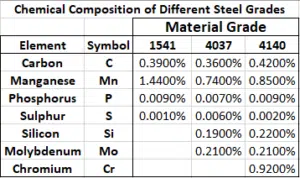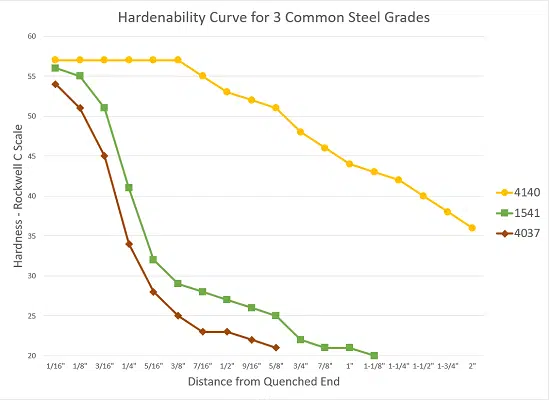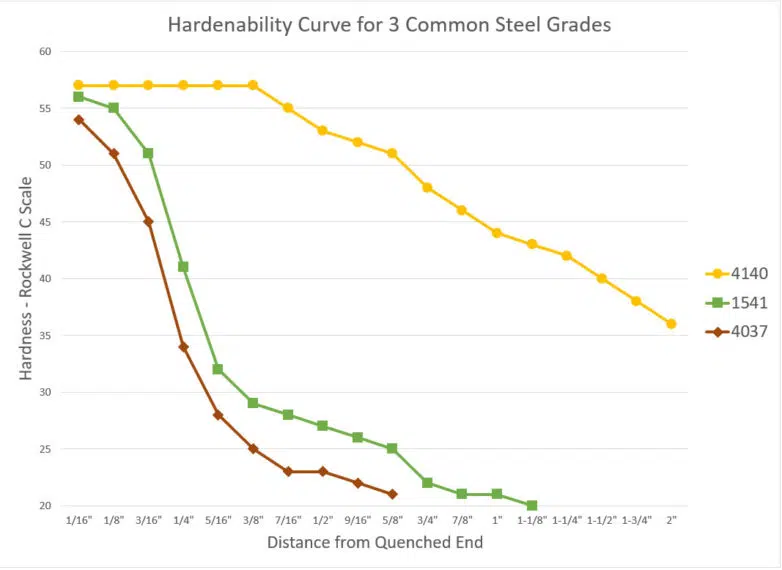Hardenability of steel is the ability of the steel to achieve a hardness value at a particular depth beneath the surface. (Click here for more information on core hardness and surface hardness in fasteners). The chemical composition of a steel provides the foundation for hardenability. The iron content in steel is around 98%. Carbon (C) is the primary hardening element. Other alloying elements such as manganese (Mn), molybdenum (Mo), chromium (Cr), and nickel (Ni) are often added in small amounts to increase hardenability. The methods of heat treatment, quenching, and tempering of steel develop the material’s metallurgical structure and mechanical properties, including hardness. A measure of steel’s hardenability aids fastener engineers in selecting materials that will produce parts with the desired surface and core hardness.
Chemical Composition Among Different Steel Grades

We should begin with some examples of different steel grades and their chemical composition, just to give an idea of the different compositions of different grades. We’ll use three grades that we at Wilson-Garner use frequently: 1541, 4037, and 4140. The chemical composition numbers below were taken directly from the steel certifications provided by our steel supplier. See Figure 1.
Hardenability Testing
As stated above, different chemical composition has an effect on hardenability. In order to quantify the differences in hardenability, engineers developed a standard reference test for hardenability, the Jominy end quench test per ASTM A255. This test provides data for the changes in hardness along the length of a 1″ diameter x 4″ long round test bar. The test is run as follows: A test bar is heated to 1600 degrees F, then quickly hung vertically in a fixture. The lower end is quenched using a room temperature water spray. After cooling, a narrow flat is ground along the surface of the 4″ length. Rockwell C hardness measurements are made on the flat surface at 1/16″ distance increments from the quenched end. The hardness results at each distance location are plotted on a graph, creating what is commonly called a Hardenability Curve.
RELATED: Need a specialty bolt, screw, or stud? Wilson-Garner can help.
Hardenability Curves
Figure 2 below shows Hardenability Curve results for three grades of steel, 1541, 4037, and 4140, using Jominy test data provided by our steel suppliers with their shipment to our company. The material at the quenched end has the fastest cooling rate and the highest hardness. Moving away from the quenched end, the cooling rate slows, and the hardness decreases. As you can clearly see from the two figures, different chemical compositions can have a major effect on the hardenability of different grades.

Steel Grade Numbering
Before we conclude, let’s take a look at the AISI/SAE nomenclature for carbon and alloy steel grade chemical compositions. The designation system consists of four numbers (XXXX). The left two digits represent the type of material, beginning with 10 (plain carbon steel) and progressing up through many alloy combinations to 98 (nickel-chromium-molybdenum steel). Here is a list of all the alloys and their designations. The right two digits represent the amount of carbon (C) in the material, expressed as a percentage by weight. This is a nominal percentage, meaning that specifications allow a range of carbon content.
Here’s an example: Grade 1038
Material Type – 10XX – Non-modified plain carbon steel.
Carbon content – XX38 – SAE carbon specification range is 0.35% minimum to 0.42% maximum (the nominal value 38 just splits the difference between the high and low limits).
Here’s another example: Grade 8640
Material Type – 86XX – Nickel-Chromium-Molybdenum Steel
Carbon Content – XX40 – SAE carbon specification range is 0.38% minimum to 0.43% maximum.
And with that, we’ve come to the end of our discussion on hardenability. If you would like to learn more about hardenability for carbon and alloy steel grades, we recommend SAE J1268 as a good reference. And click here for a primer on core and surface hardness in fasteners.

